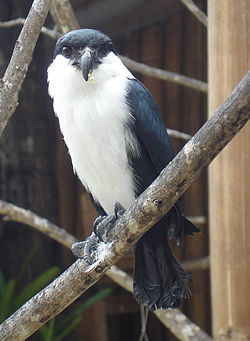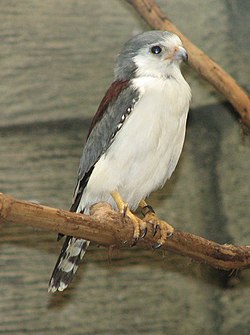| Subfamily | Image | Genus | Species |
|---|
| Herpetotherinae |  | Micrastur G.R. Gray, 1841 – forest falcons | |
|---|
 | Herpetotheres Vieillot, 1817 – laughing falcon | |
| Polyborinae |  | Spiziapteryx Kaup, 1852 | |
|---|
 | Caracara Merrem, 1826 – crested caracara | |
 | Ibycter Vieillot, 1816 | |
 | Daptrius Vieillot, 1816 | |
| Falconinae |  | Microhierax Sharpe, 1874 – typical falconets | |
|---|
 | Polihierax Kaup, 1847 | |
 | Neohierax Swann, 1922 | |
 | Falco Linnaeus, 1758 – true falcons, hobbies and kestrels | - Lesser kestrel, Falco naumanni
- Common kestrel, Falco tinnunculus
- Rock kestrel, Falco rupicolus
- Malagasy kestrel, Falco newtoni
- Mauritius kestrel, Falco punctatus
- †Reunion kestrel, Falco duboisi
- Seychelles kestrel, Falco araeus
- Spotted kestrel, Falco moluccensis
- Nankeen kestrel or Australian kestrel, Falco cenchroides
- American kestrel or "sparrow hawk", Falco sparverius
- Greater kestrel, Falco rupicoloides
- Fox kestrel, Falco alopex
- Grey kestrel, Falco ardosiaceus
- Dickinson's kestrel, Falco dickinsoni
- Banded kestrel, Falco zoniventris
- Red-necked falcon, Falco chicquera
- Red-footed falcon, Falco vespertinus
- Amur falcon, Falco amurensis
- Eleonora's falcon, Falco eleonorae
- Sooty falcon, Falco concolor
- Aplomado falcon, Falco femoralis
- Merlin or "pigeon hawk", Falco columbarius
- Bat falcon, Falco rufigularis
- Orange-breasted falcon, Falco deiroleucus
- Eurasian hobby, Falco subbuteo
- African hobby, Falco cuvierii
- Oriental hobby, Falco severus
- Australian hobby or little falcon, Falco longipennis
- New Zealand falcon or karearea, Falco novaeseelandiae
- Brown falcon, Falco berigora
- Grey falcon, Falco hypoleucos
- Black falcon, Falco subniger
- Lanner falcon, Falco biarmicus
- Laggar falcon, Falco jugger
- Saker falcon, Falco cherrug
- Gyrfalcon, Falco rusticolus
- Prairie falcon, Falco mexicanus
- Peregrine falcon, Falco peregrinus
- Taita falcon, Falco fasciinucha
|
|












